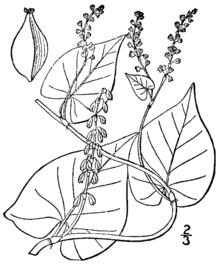Polygonum ciliinode
Polygonum ciliinode (synonym Fallopia ciliinodis[1]) is a species of flowering plant in the family Polygonaceae, native to central and eastern Canada, and the north-central and eastern United States.[1] The specific epithet is also spelt cilinode.[2]
| Polygonum ciliinode | |
|---|---|
 | |
| Drawing from the 1913 illustrated flora of the northern United States, Canada and the British Possessions | |
| Scientific classification | |
| Kingdom: | Plantae |
| Clade: | Tracheophytes |
| Clade: | Angiosperms |
| Clade: | Eudicots |
| Order: | Caryophyllales |
| Family: | Polygonaceae |
| Genus: | Polygonum |
| Species: | P. ciliinode |
| Binomial name | |
| Polygonum ciliinode | |
| Synonyms[1] | |
| |
Taxonomy
The species was first described by André Michaux in 1803.[2] Michaux spelt the epithet "cilinode".[3] Article 60 of the International Code of Nomenclature for algae, fungi, and plants requires the correction of improperly formed "compounding forms",[4] and the International Plant Names Index has corrected it to "ciliinode".[2]
Polygonum ciliinode is part of the tribe Polygoneae of the subfamily Polygonoideae.[5] However, like many species in the family Polygonaceae, it has been placed in different genera within this group, including in Fallopia and Reynoutria.[2] A 2015 molecular phylogenetic study (in which the species was treated as Fallopia cilinodis) found that it was weakly supported as a sister to the "DAP clade" (see the following cladogram), although plastid data alone placed it in the "RMF clade". The presence of extra-floral nectaries in Polygonum ciliinode suggests a relationship with the RMF clade, as this is one of the characteristics of the clade. Its relationships remain unsettled; it may represent an as-yet-unrecognized lineage in the Polygoneae.[5]
| Polygoneae |
| ||||||||||||||||||||||||||||||||||||||||||
References
- "Polygonum cilinode Michx.", Plants of the World Online, Royal Botanic Gardens, Kew, retrieved 2019-03-04
- "Plant Name Details for Polygonum ciliinode Michx.", The International Plant Names Index, retrieved 2019-03-04
- Michaux, Andreas (1803), "Polygonum cilinode", Flora boreali-americana, sistens caracteres plantarum quas in America septentrionali collegit et detexit Andreas Michaux (in Latin), 1, Paris: Levrault, p. 241, retrieved 2019-03-04
- Turland, N.J.; et al., eds. (2018), "Art. 60", International Code of Nomenclature for algae, fungi, and plants (Shenzhen Code) adopted by the Nineteenth International Botanical Congress Shenzhen, China, July 2017 (electronic ed.), Glashütten: International Association for Plant Taxonomy, retrieved 2019-03-04
- Schuster, Tanja M.; Reveal, James L.; Bayly, Michael J. & Kron, Kathleen A. (2015), "An updated molecular phylogeny of Polygonoideae (Polygonaceae): Relationships of Oxygonum, Pteroxygonum, and Rumex, and a new circumscription of Koenigia", Taxon, 64 (6): 1188–1208, doi:10.12705/646.5